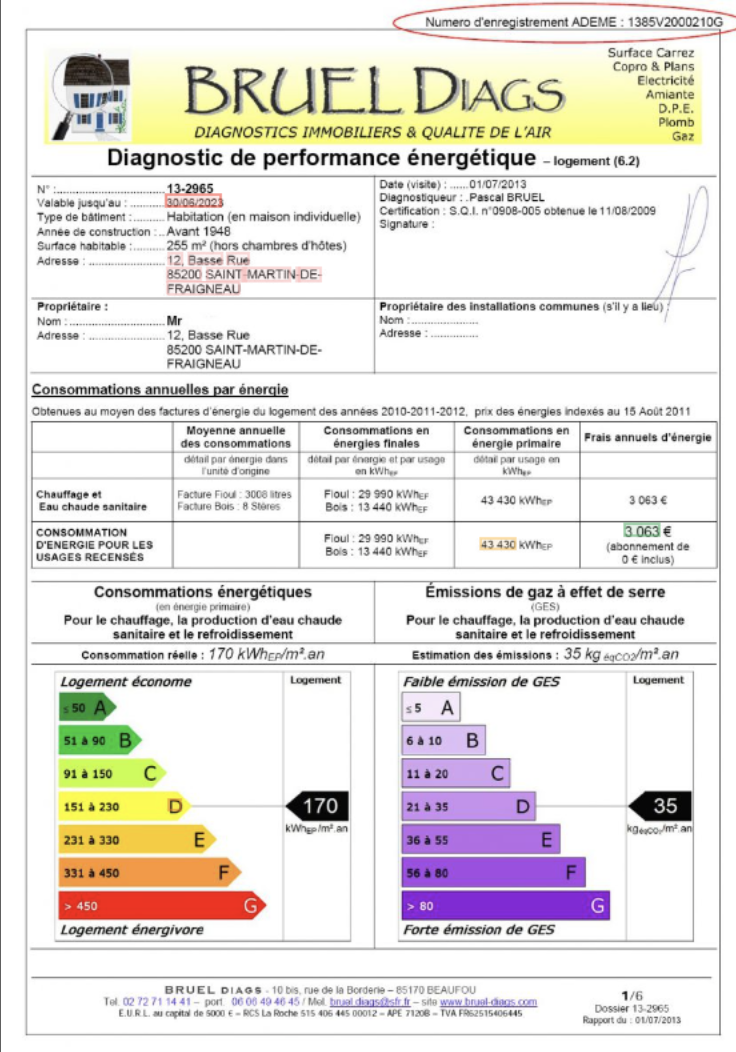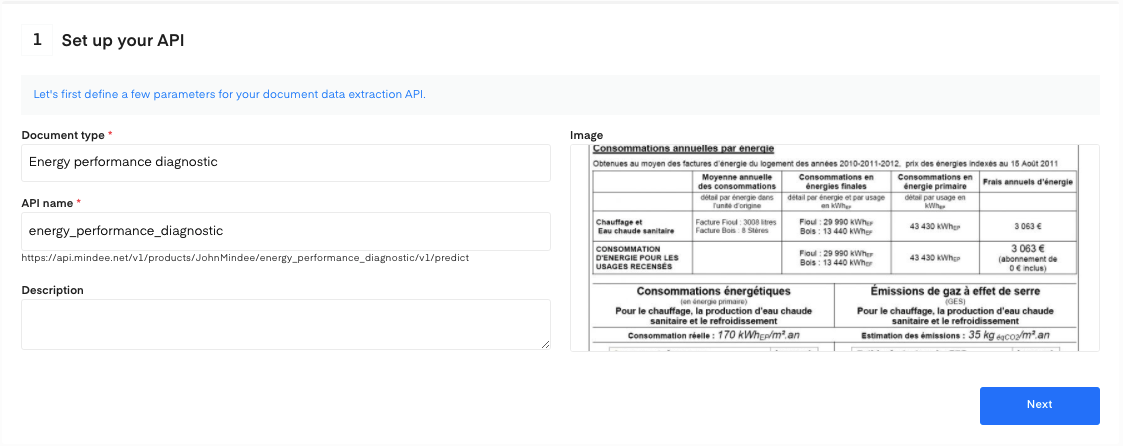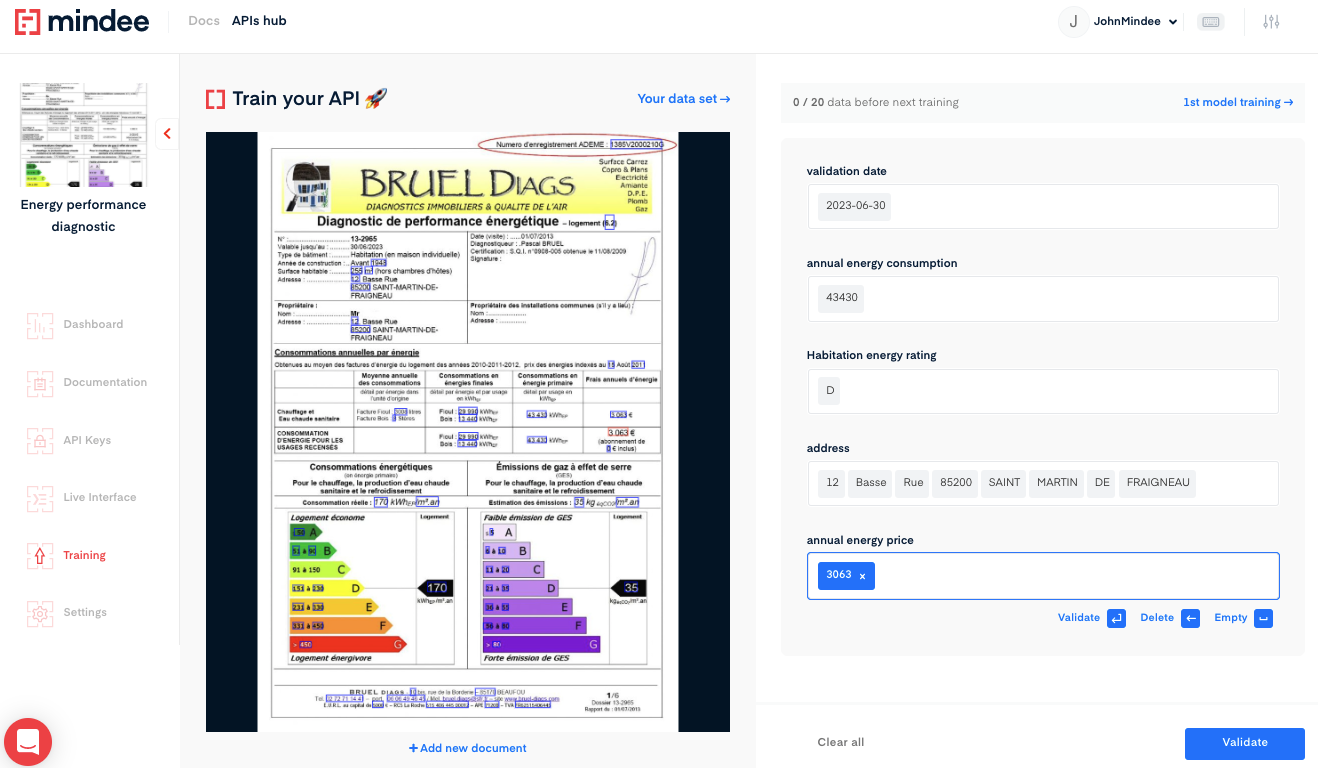Energy Performance Diagnostic
This section describes how to build your custom OCR API to extract data from the Energy performance Diagnostic document using the API Builder. The Energy Performance Diagnostic (DPE) is a document that gives an estimate of the energy consumption and greenhouse gas emission rates of your home
Prerequisites
You’ll need at least 20 energy Performance Diagnostic images or pdfs to train your OCR.
Define Your Energy Performance Diagnostic (DPE) Use Case
Using the Energy Performance Diagnostic below, we’re going to define the fields we want to extract from it.

- Validation date: 30/06/2022
- Annual energy consumption : 43430 KW/h
- Habitation energy rating : D
- Address: 12 Basse Rue, 85200 SAINT MARTIN DE FREIGNEAU
- Annual energy price: 3063€
That’s it for this example. Feel free to add any other relevant data to fit your requirements.
Deploy Your API
Once you have defined the list of fields you want to extract from your Energy Performance Diagnostic, head over to the platform and follow these steps:
-
Click on the Create a new API button on the right.
-
Next, fill in the basic information about the API you want to create as seen below.

- Click on the Next button. The following page allows you to define and add your data model.
Define Your Model
There are two ways to add fields to your data model.

Upload a JSON Config
To add data fields using JSON config upload.
- Copy the following JSON into a file.
{
"problem_type": {
"classificator": { "features": [], "features_name": [] },
"selector": {
"features": [
{
"cfg": { "filter": { "convention": "FR" } },
"handwritten": false,
"name": "validation_date",
"public_name": "validation date",
"semantics": "date"
},
{
"cfg": { "filter": { "is_integer": 1 } },
"handwritten": false,
"name": "annual_energy_consumption",
"public_name": "annual energy consumption",
"semantics": "amount"
},
{
"cfg": { "filter": { "alpha": -1, "numeric": 0 } },
"handwritten": false,
"name": "habitation_energy_rating",
"public_name": "Habitation energy rating",
"semantics": "word"
},
{
"cfg": { "filter": { "alpha": -1, "numeric": -1 } },
"handwritten": false,
"name": "address",
"public_name": "address",
"semantics": "word"
},
{
"cfg": { "filter": { "is_integer": -1 } },
"handwritten": false,
"name": "annual_energy_price",
"public_name": "annual energy price",
"semantics": "amount"
}
],
"features_name": [
"validation_date",
"annual_energy_consumption",
"habitation_energy_rating",
"address",
"annual_energy_price"
]
}
}
}
- Click on Upload a JSON config.
- The data model will be automatically filled.
- Click on Create API at the bottom of the screen.

Manually Add Data
Using the interface, you can manually add each field for the data you are extracting. For this example, here are the different field configurations used:
- Validation date: type Date in the European default format
- Annual energy consumption: type Number
- Habitation energy rating: type String contains only alpha characters
- Address: type String with both numeric and alpha characters.
- Annual energy price: type Number
Once you’re done setting up your data model, click the Create API button at the bottom of the screen.

Train Your Energy Performance Diagnostic OCR
You’re all set! Now it's time to train your Energy Performance Diagnostic deep learning model in the Training section of our API.

- Upload one file at a time or a zip bundle of many files.
- Click on the field input on the right, and the blue box on the left highlights all the corresponding field candidates in the document.
- Next, click on the validate arrow for all the field inputs.
- Once you have selected the proper box(es) for each of your fields as displayed on the right-hand side, click on the validate button located at the right-side bottom to send an annotation for the model you have created.
- Repeat this process until you have trained 20 documents to create a trained model.
To get more information about the training phase, please refer to the Getting Started tutorial.
Questions?
![]() Join our Slack
Join our Slack
Updated over 1 year ago
